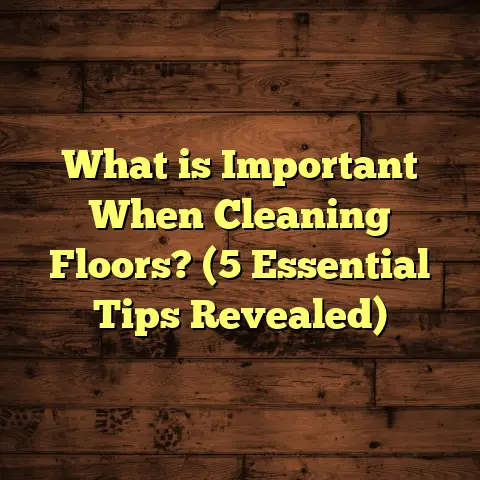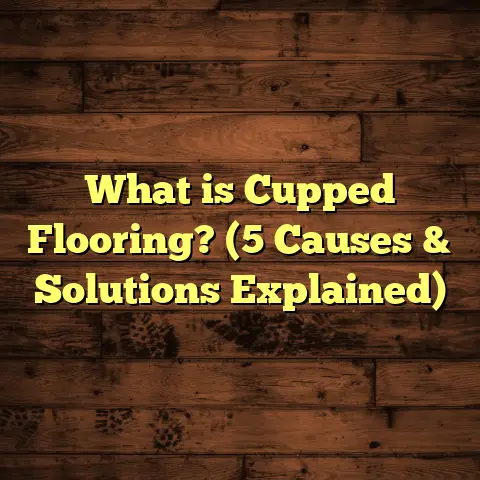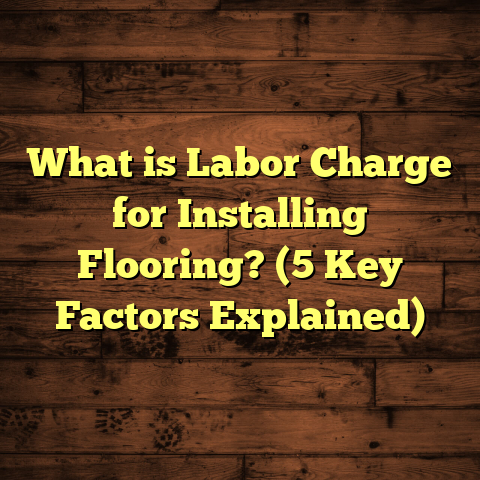What is Resilient Flooring? (5 Key Benefits You Must Know!)
“Resilient flooring offers the perfect balance of durability, comfort, and style—making it a favorite among homeowners and contractors alike.”
— Mark Stevens, Flooring Industry Expert
What is Resilient Flooring?
Let me start by answering the question that probably crossed your mind first: what exactly is resilient flooring? Simply put, resilient flooring is a type of floor covering designed to bend, compress, and recover without damage. It’s soft enough to absorb shocks but tough enough to handle heavy foot traffic and everyday wear. If you want a floor that’s both flexible and durable, resilient flooring fits that bill.
The term covers a range of materials—vinyl, linoleum, cork, rubber, and even some composite materials. These floors are manufactured to resist dents, scratches, and moisture better than rigid flooring options like hardwood or ceramic tile.
From my own experience as a flooring contractor, I’ve seen resilient floors perform exceptionally well in environments where other floors often fail. Whether in busy homes with kids and pets or high-traffic commercial spaces, resilient floors offer long-lasting performance without sacrificing style.
What Makes Resilient Flooring Unique?
Unlike hard surfaces that crack or chip under pressure, resilient flooring absorbs impact and springs back. This characteristic comes from its flexible composition—usually layers of backing, reinforcement, and a wear layer that protects against scratches and stains.
Here’s a quick breakdown of common resilient flooring types I’ve worked with:
- Vinyl: Available as sheets, tiles, or planks; vinyl is water-resistant, easy to clean, and mimics wood or stone effectively.
- Linoleum: Made from natural materials like linseed oil, cork dust, and wood flour; it’s eco-friendly and antimicrobial but requires regular sealing.
- Cork: Harvested from tree bark; cork floors feel soft underfoot and provide excellent insulation but can be vulnerable to moisture if not sealed well.
- Rubber: Extremely durable and slip-resistant; common in gyms, hospitals, and schools for safety and noise reduction.
I always advise clients to consider the environment the floor will live in before choosing a resilient material. For example, vinyl works great in wet areas like bathrooms or kitchens, while cork is better suited for living rooms or bedrooms where moisture is less of a concern.
1. Durability That Stands the Test of Time
One of the biggest selling points for resilient flooring is its durability. When I tell homeowners this, they often ask: “How durable can it really be?” So here’s what I’ve learned from years on job sites.
Scratch and Impact Resistance
Resilient floors are usually topped with a wear layer—a transparent coating that protects against scratches, scuffs, and stains. Vinyl planks with a thicker wear layer tend to last longer in high-traffic areas.
For example, I installed luxury vinyl planks (LVP) in an office space with heavy rolling chairs and saw minimal wear after three years. Compared to hardwood floors nearby that showed dents from dropped tools, the resilient floor held up remarkably well.
Water Resistance
This is where resilient flooring really beats out hardwood. Moisture can warp wood or cause mold issues under carpet. Vinyl and rubber floors are waterproof or water-resistant by design.
One job I did was in a basement laundry room prone to flooding after heavy rain. The client chose sheet vinyl with welded seams for a watertight surface. After two years with occasional water issues, the floor still looks great—no bubbling or warping.
Longevity
How long will resilient floors last? According to industry data:
- Vinyl floors typically last 15–25 years
- Linoleum can last up to 40 years with proper care
- Cork floors tend to have a lifespan of 20–30 years
- Rubber floors can last over 30 years in commercial settings
In my projects, I’ve seen vinyl floors easily outlive expectations when installed correctly and maintained well. For example, one retail store I did had vinyl tile floors for over 20 years before needing replacement due to design updates rather than wear.
2. Comfort Underfoot
Have you ever stood on tile for hours during a party or while cooking? Your feet probably cried out for relief. Resilient flooring offers a softer surface that absorbs shock and reduces fatigue.
Why Comfort Matters
Standing on hard floors can cause discomfort in your joints over time. This is especially important if you spend long hours standing in your kitchen or work environment.
I remember installing cork flooring in a yoga studio once. The instructor mentioned how much easier it was on their feet after long sessions compared to previous hardwood floors. That kind of comfort can make a big difference daily.
Sound Absorption
Many resilient materials help reduce noise by absorbing sound vibrations. This quality is great for apartments or multi-story homes where footsteps can carry downstairs.
Rubber flooring especially cuts down noise significantly—perfect for gyms or classrooms where loud activities happen regularly.
3. Easy Maintenance and Cleaning
If you’re like most homeowners I talk to, you want flooring that’s simple to keep clean without special treatments or expensive products. Resilient floors fit this need perfectly.
Routine Cleaning
A quick sweep or vacuum removes dust and grit that could scratch your floor over time. For more thorough cleaning, a damp mop with mild detergent usually does the trick.
In one home I worked on, the busy parents appreciated how fast cleaning was after their kids’ arts-and-crafts sessions—no staining on the resilient vinyl even after paint spills.
Stain Resistance
Vinyl and rubber floors usually have protective coatings that resist stains from coffee, wine, oils, or ink. This means no more worrying about accidents ruining your floor’s look.
Linoleum needs periodic sealing to maintain its stain resistance but remains quite manageable with simple care routines.
Avoiding Damage
It’s smart to use furniture pads under heavy pieces to avoid dents and protect the floor surface. Also, avoid harsh chemicals or abrasive tools which can degrade the protective layer over time.
4. Wide Variety of Styles and Designs
One misconception people have about resilient flooring is that it looks cheap or boring. That couldn’t be further from the truth.
Thanks to advances in printing technology and manufacturing processes, resilient flooring can mimic almost any look you want—from rustic hardwood to polished marble.
Realistic Textures and Patterns
Luxury vinyl planks often feature embossed textures that feel like real wood grain underfoot. Linoleum comes in vibrant colors and patterns suitable for retro or modern designs.
Rubber flooring offers bright colors ideal for schools or gyms needing functional yet fun spaces.
Customization
For commercial projects especially, I’ve used custom-colored rubber tiles imprinted with logos or patterns to reinforce branding while meeting durability needs.
Even cork can be stained or finished differently to match various decor styles—from light Scandinavian vibes to rich Mediterranean warmth.
5. Cost-Effectiveness Without Compromise
Budget is always a concern whether you’re updating your home or outfitting a business space. Resilient flooring strikes a smart balance between cost and performance.
Average Costs Breakdown
Here’s a detailed look at price ranges based on my experience working across different regions:
| Material | Material Cost per Sq. Ft | Installation Cost per Sq. Ft | Total Cost per Sq. Ft |
|---|---|---|---|
| Vinyl Plank | $2 – $5 | $1.50 – $3 | $3.50 – $8 |
| Linoleum | $3 – $6 | $2 – $4 | $5 – $10 |
| Cork | $3 – $7 | $2 – $5 | $5 – $12 |
| Rubber | $4 – $8 | $3 – $6 | $7 – $14 |
These costs vary based on quality, brand, installation complexity, and local labor rates.
How I Use FloorTally for Cost Estimation
When planning projects—and juggling client budgets—I rely heavily on FloorTally. This tool lets me input local prices for materials and labor along with waste factors so I get precise estimates quickly.
It saves me from guesswork or back-and-forth calls trying to nail down pricing from multiple vendors. Plus, it helps me compare different flooring options side-by-side based on cost-effectiveness—essential when clients want stylish yet affordable solutions.
Practical Uses of Resilient Flooring Based on Real Projects
Let me share some applications where I’ve seen resilient flooring really shine:
Residential Kitchens & Bathrooms
Moisture resistance makes vinyl and linoleum perfect candidates here. In one kitchen remodel I completed recently, we installed waterproof vinyl planks that resisted spills and humidity without any warping.
Commercial Spaces: Offices & Retail
High foot traffic demands durable solutions. I installed rubber tiles in a busy clinic reception area which significantly reduced noise and cleaned easily between patients.
Schools & Daycares
Safety is key with kids running around. Rubber flooring’s slip resistance combined with comfort made it the go-to choice for several daycare centers I worked on—they also loved how easy it was to clean up art messes.
Basements & Laundry Rooms
These areas often face moisture challenges—resilient flooring saves the day by preventing water damage common with carpet or hardwood here.
Installation Insights: What You Should Know Before Starting
I always emphasize that proper installation makes all the difference between a floor that lasts decades versus one that fails early.
Subfloor Preparation Is Key
Before laying any resilient material, the subfloor must be:
- Cleaned thoroughly—dust and debris cause adhesion issues
- Evened out—uneven surfaces lead to bubbles or cracks later
- Dry—as moisture trapped underneath ruins flooring integrity
Skipping these steps can lead to costly repairs down the road (and I’ve seen plenty of jobs where poor prep caused premature failure).
Installation Methods Vary by Material
Here are installation approaches I use depending on material choice:
- Glue-down: Mostly for sheet vinyl or linoleum; adhesive bonds floor securely but requires drying time.
- Click-lock (floating): Popular for vinyl planks; boards snap together over underlayment—easy for DIYers.
- Loose lay: Heavier vinyl sheets/planks stay down by weight alone; great for rentals or temporary setups.
Each method has pros and cons related to cost, durability, and ease of replacement if needed.
Tools You’ll Need
Basic tools for installation include:
- Utility knife for cutting edges
- Tape measure for precise layout
- Floor roller for adhesive application
- Straight edge for clean cuts
I always recommend renting specialty tools if you don’t own them already—it saves headaches during installation day.
Maintaining Your Resilient Floors: Tips That Work Every Time
Want your resilient floors looking fresh year after year? Here’s my personal maintenance checklist:
- Sweep/vacuum regularly to remove dirt particles
- Mop with mild detergent—avoid harsh chemicals
- Clean spills immediately to avoid staining
- Use felt pads under furniture legs
- Place mats at entry points to catch dirt
- Avoid waxing unless recommended by manufacturer
One client with elderly parents loved my suggestion to install cork in hallways paired with non-slip mats—both safe and easy to maintain.
Personal Stories About Resilient Flooring
Over many years working as a contractor, I’ve gathered plenty of stories showing why this flooring category is so popular:
- A young couple renovating their starter home wanted affordable wood-look floors but worried about pets scratching hardwood. Vinyl plank was perfect—they loved how pet nails didn’t leave marks after two years of dogs running around.
- In a daycare center project, rubber tile installation not only improved safety but slashed noise complaints from neighboring offices—teachers appreciated the calmer environment instantly.
- A restaurant owner once told me he saved thousands switching from ceramic tile to sheet vinyl in kitchen prep areas due to easier maintenance and faster installation turnaround.
These experiences show resilient flooring isn’t just practical—it often solves problems other floors can’t.
Data & Research Backing Resilient Flooring Benefits
To back up what I’ve seen firsthand, here are some relevant statistics:
- The Resilient Floor Covering Institute reports over 40% of all commercial flooring installations in North America use vinyl products due to durability and affordability.
- A survey of 500 homeowners found 68% preferred resilient options in moisture-prone areas because they resist damage better than hardwood or carpet.
- A school renovation case study showed switching old carpets to rubber tiles reduced maintenance costs by 30% over five years due to easier cleaning and lifespan.
- According to industry data, resilient floors typically require 25–40% less energy during production compared with ceramic tile or hardwood—making them more environmentally friendly choices as well.
Common Questions About Resilient Flooring (Answered)
Will Resilient Flooring Fade Over Time?
Quality products have UV-resistant coatings that prevent fading even in sunny rooms. Lower-end materials may discolor after years but proper maintenance extends lifespan significantly.
Can You Install Resilient Floors Over Existing Floors?
Often yes—vinyl planks especially can be installed right over concrete or wood subfloors if smooth and level—but removing old carpet or damaged tile first is best practice.
How Do Resilient Floors Feel Compared to Hardwood?
They’re softer underfoot due to their flexible nature but still firm enough for stability—plus warmer than tile or stone options.
Final Thoughts From Me
If you want floors that combine toughness with flexibility—and don’t break your budget—resilient flooring deserves serious thought. Its mix of durability, comfort, style variety, ease of care, and affordability make it an outstanding option for nearly any room.
Remember: successful projects come down not just to material choice but proper installation and upkeep too. Use tools like FloorTally if budgeting feels overwhelming—they help me plan better by comparing costs accurately based on local rates plus waste factors.
I hope my stories and insights help you feel confident exploring resilient flooring options for your space! If you want advice tailored specifically to your home or business needs—or help picking materials—I’m happy to chat more anytime.
What’s your next flooring project? Have you tried resilient options before?





